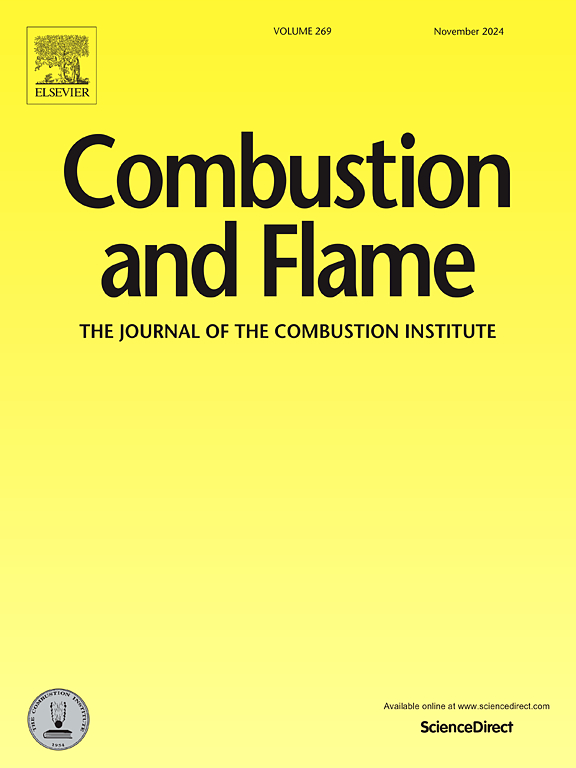Steady hot and cool dimethyl ether premixed flames in channels with wall heat loss
IF 5.8
2区 工程技术
Q2 ENERGY & FUELS
引用次数: 0
Abstract
The present work numerically investigates the role of wall heat loss on the propagation of stoichiometric dimethyl ether (DME)/air premixed cool flames in channels, with emphasis on the extinction limits, transition from cool to hot flames and the possibility of observing both cool and hot flame propagation in a channel of a given width and wall thermal condition. The premixed DME/air flame is simulated in a two-dimensional (2D) semi-open narrow channel employing a detailed kinetic model. The study focuses on the impact of the channel width, heat loss intensity and the initial hot kernel temperature on the formation of a steady cool or hot flame, the relevant quenching channel half-width and the transition between cool and hot flames. The results indicate that, as the wall heat loss intensity is increased, the quenching channel width for the cool flames increases as well. Transition to hot flame is observed for larger channel widths. For such a transition, the propagation of a cool flame front starts first, then a hot flame front appears behind it, and subsequently catches up with it. The critical channel width for the cool to hot flame transition (two-stage ignition) increases with heat loss intensity. As for the effect of the initial kernel temperature on the flame regime, stable cool flames were obtained for a certain range of channel widths for lower initial kernel temperatures. A non-monotonic dependence of the critical channel width for the two-stage ignition on the initial kernel temperature is shown to be related to NTC effects. Initial kernel temperatures larger than 1100 K resulted in the direct formation of a hot flame. In a preliminary study for non-stocihiometric mixtures, it was demonstrated that double cool and hot flame configuration can be observed for very lean or rich mixtures.
Novelty and Significance Statement
Propagation of premixed DME/air flames ignited at a closed end of a micro-channel in the presence of wall heat loss was studied numerically. For the first time, it was observed that both stable cool flame and stable hot flame can be established independently in a channel of a given width and wall thermal conditions. Regime diagrams for the emergence of cool and hot flames were obtained numerically for different channel widths, thermal resistance coefficients, and initial kernel temperatures. Despite active research into cool flames in DME-air mixtures in the past years, there are very few studies on the regimes of cool and hot DME flame propagation in channels, both numerical and experimental. This is the first systematic parametric study of DME-air premixed flames in micro-channels of different widths.
本研究以数值方法研究了壁面热损失对化学计量二甲醚(DME)/空气预混合冷火焰在通道中传播的影响,重点是熄灭极限、冷火焰向热火焰的过渡以及在给定宽度和壁面热条件的通道中同时观察冷火焰和热火焰传播的可能性。采用详细的动力学模型模拟了二甲醚/空气预混合火焰在二维(2D)半开放式狭窄通道中的情况。研究重点是通道宽度、热损失强度和初始热核温度对稳定冷焰或热焰的形成、相关淬火通道半宽以及冷焰和热焰之间过渡的影响。结果表明,随着壁面热损失强度的增加,冷焰的淬火通道宽度也随之增加。通道宽度越大,火焰越热。在这种过渡过程中,首先是冷火焰前沿开始传播,然后在其后面出现热火焰前沿,最后赶上冷火焰前沿。冷焰向热焰过渡(两级点火)的临界通道宽度随着热损失强度的增加而增加。至于初始内核温度对火焰状态的影响,在较低的初始内核温度下,在一定的通道宽度范围内可以获得稳定的冷火焰。两阶段点火的临界通道宽度与初始内核温度的非单调依赖关系与 NTC 效应有关。初始内核温度大于 1100 K 会直接形成高温火焰。对非吸热混合物的初步研究表明,在极贫或极富的混合物中可以观察到双冷焰和热焰配置。研究首次发现,在给定宽度和壁面热条件的通道中,可以独立形成稳定的冷火焰和稳定的热火焰。在不同的通道宽度、热阻系数和初始内核温度下,通过数值计算得到了冷焰和热焰出现的时序图。尽管在过去几年中对二甲醚-空气混合物中的冷火焰进行了积极研究,但对二甲醚火焰在通道中的冷和热传播机制进行的数值和实验研究却很少。这是首次对不同宽度微通道中的二甲醚-空气预混合火焰进行系统的参数研究。
本文章由计算机程序翻译,如有差异,请以英文原文为准。
求助全文
约1分钟内获得全文
求助全文
来源期刊

Combustion and Flame
工程技术-工程:化工
CiteScore
9.50
自引率
20.50%
发文量
631
审稿时长
3.8 months
期刊介绍:
The mission of the journal is to publish high quality work from experimental, theoretical, and computational investigations on the fundamentals of combustion phenomena and closely allied matters. While submissions in all pertinent areas are welcomed, past and recent focus of the journal has been on:
Development and validation of reaction kinetics, reduction of reaction mechanisms and modeling of combustion systems, including:
Conventional, alternative and surrogate fuels;
Pollutants;
Particulate and aerosol formation and abatement;
Heterogeneous processes.
Experimental, theoretical, and computational studies of laminar and turbulent combustion phenomena, including:
Premixed and non-premixed flames;
Ignition and extinction phenomena;
Flame propagation;
Flame structure;
Instabilities and swirl;
Flame spread;
Multi-phase reactants.
Advances in diagnostic and computational methods in combustion, including:
Measurement and simulation of scalar and vector properties;
Novel techniques;
State-of-the art applications.
Fundamental investigations of combustion technologies and systems, including:
Internal combustion engines;
Gas turbines;
Small- and large-scale stationary combustion and power generation;
Catalytic combustion;
Combustion synthesis;
Combustion under extreme conditions;
New concepts.
 求助内容:
求助内容: 应助结果提醒方式:
应助结果提醒方式:


